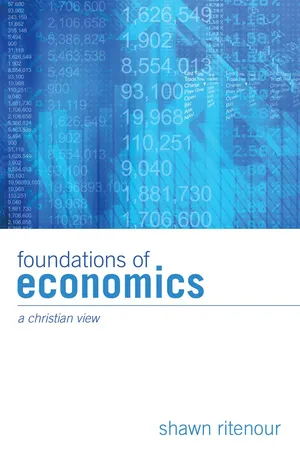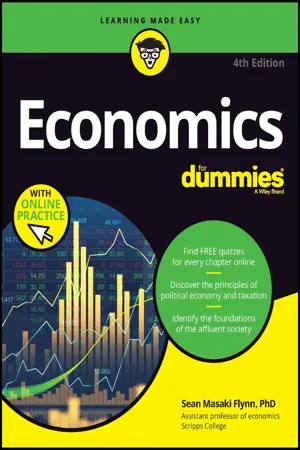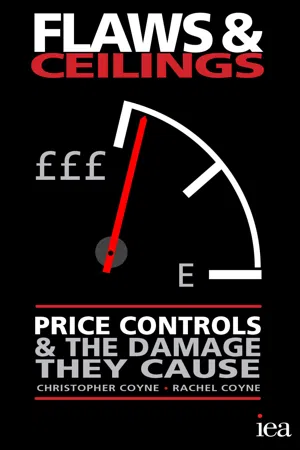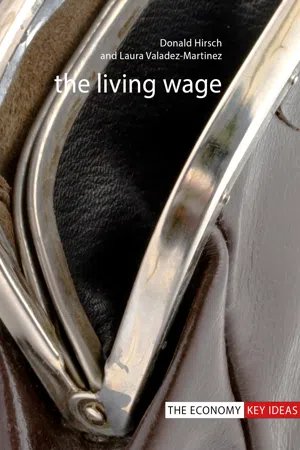Economics
Price Floors
Price floors are government-imposed limits on how low a price can be set for a particular good or service. They are designed to protect producers by ensuring they receive a minimum price for their products. When a price floor is set above the equilibrium price, it can lead to surpluses as the quantity supplied exceeds the quantity demanded.
Written by Perlego with AI-assistance
Related key terms
7 Key excerpts on "Price Floors"
- eBook - ePub
Foundations of Economics
A Christian View
- Ritenour(Author)
- 2010(Publication Date)
- Wipf and Stock(Publisher)
As the name implies, a price floor is a minimum legal price. Just as a ceiling constrains how high something can go, the floor constrains how low it can go. If you were to take this book and throw it down as hard and as far as it could go, the floor stops it from going any lower. A price floor is the lowest price that buyers can legally pay and that sellers can legally receive. Just as there are effective and ineffective price ceilings, there are effective and ineffective Price Floors. An effective price floor affects the price actually paid and received on the market. As can be seen from the graph in figure 15.4, a price floor will be effective if it is greater than the market price. Figure 15.4. An effective price floor is a minimum legal price fixed above the market price. It always results in a surplus. In this case, the price floor P F is above the market price P Mkt. The graph shows us that such a price floor will indeed have a noticeable effect. The immediate effect of such a price floor is a surplus. The demand and supply curves tell us that at the price floor the quantity of the good demanded is Q D and the quantity of the good supplied is Q S. At the floor, the quantity supplied is greater than the quantity demanded. This results in excess supply. In a free market, there is no need to worry about such a state of affairs because it never lasts long. Excess supply results in frustrated sellers, to be sure, because some suppliers who are willing to sell at the price floor but cannot because there is not enough demand. Consequently, in an effort to ensure that they are the ones who actually do get to sell, the more eager sellers will bid down the price. As the price falls, the less eager sellers leave the market. At the same time the lower price increases the quantity of the good demanded. The more eager sellers will continue to bid down the price until everyone who wants to sell can sell - eBook - ePub
Economics For Dummies
Book + Chapter Quizzes Online
- Sean Masaki Flynn(Author)
- 2023(Publication Date)
- For Dummies(Publisher)
The equilibrium quantity falls when supply decreases because the increase in production costs doesn’t just affect the producer. To stay in business, the producer has to pass along the cost increase. But when the increase is passed on, it tends to discourage buyers. The result is that the equilibrium quantity falls because some buyers aren’t willing to pay the higher prices. Those who still want to buy are willing to pay the higher prices — a fact that’s reflected in the increased market price.Price Controls: Keeping Prices Away from Market Equilibrium
Left to its own devices, a market always adjusts until the price and quantity are determined by where the demand and supply curves cross. The benefit of the market equilibrium price is that everyone who wants to buy at that price can do so, and everyone who wants to sell at that price can also. In other words, the quantity demanded equals the quantity supplied.However, the market price isn’t always the politically expedient price, and governments sometimes interfere in markets to prevent the market equilibrium from being reached. Such interventions happen because politically influential buyers think the market price is too high or because politically influential sellers believe it’s too low.Unfortunately, government intervention creates a whole new set of problems related to the misallocation of resources. In some cases, government intervention even hurts those whom the intervention is designed to help. In this section, I explain the effects of two kinds of government intervention: price ceilings and Price Floors. Price ceilings prevent prices from rising to the market equilibrium, whereas Price Floors keep prices from falling to the market equilibrium. (Obviously, you use only one or the other!)Setting upper limits with price ceilings
Sometimes the government intervenes in a market to ensure that the price stays below the market equilibrium price,P* .Such policies are called price ceilings because they prevent the price from rising as high as it would if left alone. Prices hit the ceiling and then go no higher.You may have heard about price ceilings on apartment rent. For instance, in an attempt to provide low-cost housing for those lacking much in the way of finances, city governments may place price ceilings on how much a landlord can charge. The problem is that with prices artificially low, the quantity demanded is greater than the quantity supplied, creating a shortage. - eBook - ePub
Global Food Security
What Matters?
- Zhang-Yue Zhou(Author)
- 2019(Publication Date)
- Routledge(Publisher)
Clearly, this policy tool is counterproductive in boosting a country’s food supply and does not help a country to balance its food demand and supply. Its adoption works against a country’s effort to improve food security. It is often used in low-income and food-insecure countries to lower prices for non-farming consumers at the expense of producers. In the long run, it generally also works against the interest of consumers when food supply shortages become persistent.Many countries have used this policy measure, which has always contributed to their food shortages. These countries include, for example, China, Vietnam, North Korea, and Venezuela. China and Vietnam have abandoned this policy tool, but others are still practising this policy (North Korea) or have recently introduced it (Venezuela).9.3.2 Price floor
A price floor is a government-imposed price control, or limit, on the minimum price paid to farmers. In order to be effective (binding), a price floor must be higher than the equilibrium price.When the price floor is set above the market equilibrium price, consumers find they are now paying a higher price for the same product and subsequently they reduce their purchases. In the meantime, suppliers find they are guaranteed a new, higher price than they were receiving before and they are happy to increase production. The combined effect is that there is now an excess supply. This then leads to surplus transfers and DWL.What does a government do with the excess supply? There are two common approaches a government can use. (1) The government buys the excess to store, destroy, or export. (2) It makes a deficiency payment to producers. - eBook - ePub
Power, Property Rights, and Economic Development
The Case of Bangladesh
- Mohammad Dulal Miah, Yasushi Suzuki(Authors)
- 2018(Publication Date)
- Palgrave Macmillan(Publisher)
equity markets in New Zealand listed public companies.Price control can also be related to fixing the floor price for certain goods or services. Minimum wage rate is one prominent example of fixing the floor price (Lemos 2009 ). Although the rationale of minimum wage can be derived from Marxian egalitarian view of wealth distribution (see Elster 1986 ; Suzuki and Miah 2017 ), Adam Smith was also vocal in favor of minimum wage (Kaufman 2016 ). The basic argument in favor of minimum wage is that it attracts a greater number of workforce, which will reduce unemployment and increase the overall production (Giuliano 2013 ). Similarly, fixing the floor price of some products ensures that producers get sufficient price to continue their productions.Despite some economic rationality in favor of price control, this mechanism has failed, more often than not, to achieve the intended purpose. The primary reason is that price ceiling creates shortages of goods for which price is controlled. Friedman (1977 ) argues:We economists don’t know much, but we do know how to create a shortage . If you want to create a shortage of tomatoes, for example, just pass a law that retailers can’t sell tomatoes for more than two cents per pound. Instantly you’ll have a tomato shortage . It’s the same with oil or gas.Nillesen and Pollitt (2007 ) show a huge financial loss resulting from control of tariff on electricity distribution and transmission in the Netherlands . Davis and Kilian (2011 ) estimate that the allocative cost for the US residential market for natural gas, which was subject to price ceiling during 1954–1989, averaged US$3.6 billion annually. Similarly, rent control for residential apartments has resulted in various misallocation across demographic groups and subgroups (Glaeser and Luttmer 2003 ), inadequate maintenance due to low economic profits for landlords (Cheung 1979 ; Gyourko and Linneman 1990 ), and reduced mobility in the housing market (Clark and Heskin 1982 ). Navissi et al. (1999 ) provide evidence which shows that equity values of listed firms in New Zealand were negatively associated with the price control. Moreover, the effects of price control on related markets are also reported in the literature (Gould and Henry 1967 - eBook - ePub
Economic Behaviour (Routledge Revivals)
An Introduction
- Colin Harbury(Author)
- 2013(Publication Date)
- Routledge(Publisher)
CF ) at the legal maximum price. In the absence of intervention, the presence of excess demand over supply would tend to force price upwards. Here it is prohibited. If nothing further is done, one might not be surprised, therefore, to find queues or black markets developing (as, for example, with cup final tickets). Hence price controls are often accompanied by procedures for the orderly allocation of scarce supplies (for example, residence qualifications for council houses or ration coupons for food in wartime).Minimum prices create parallel but different problems. In Figure 10.2 , if the legal minimum price is set at OP min., there will ensue an excess of supply over demand, of AB. In a free market, economic forces would tend to lower price. This is excluded here, so one must expect some output to be unsold. Suppose, for example, the market was for unskilledFigure 10.2 Price controls effecting market equilibrium.labour and the minimum price was introduced by the government to put a floor to wages. Unemployment, however, would ceteris paribus , tend to occur. (AE fewer workers would find jobs than if wages were allowed to fall to the equilibrium level.) It would, therefore, be unwise to introduce such a measure without recognising its full implications.5Rules and regulations
We turn next to consider how the state can exert influences on markets by means of rules and regulations. These can take the form of absolute prohibitions and compulsions or more general measures affecting the legal and institutional framework within which the price mechanism works.Rules of absolute prohibition or compulsion may be resorted to when supply and/or demand is insensitive to price, when alternative policies are impracticable or very costly, or when the allocation of resources brought about by market forces is considered so unsatisfactory that nothing less will do.It may be helpful to give a few examples of this type of intervention. Certain kinds of pollution may be absolutely prohibited, where the effects would be extremely serious or where the cost of measuring pollution and monitoring a system of taxes would be very expensive. Bus lanes may be barred from private motorists; factory building may be forbidden in highly congested areas; the import of animals carrying health risks may be banned; and so on. Absolute prohibitions, of course, deprive individuals of freedom of choice. In some cases, compromise solutions of partial bans may be appropriate — for example, the division of trains into compartments where smoking is, or is not, allowed. - eBook - ePub
Flaws and Ceilings
Price Controls and the Damage They Cause
- Christopher Coyne, Rachel Coyne, Philip Booth, Ryan Bourne, Stephen Davies, Robert Miller, Colin Robinson, Steven Schwartz, W. Stanley Siebert, Christopher Snowdon, Richard Wellings(Authors)
- 2015(Publication Date)
- London Publishing Partnership(Publisher)
4. The simple economics of wage floors
W. S. SiebertMy daughter’s ambition is to get a job in an office. She has Down’s syndrome. She thinks that, if she works hard, someone, somewhere will give her a job. At £6.50 per hour, it’s never going to happen. But at £2 per hour? Maybe.Letter from Candice Baxter tothe Daily Telegraph , 17 October 2014There is now no sizeable lobby in the UK campaigning for the abolition of the minimum wage…. In a poll of experts by the Institute for Government the minimum wage was voted the most successful UK government policy of the past 30 years, ahead of the Northern Ireland peace process.Manning (2013: 65)Introduction
A wage floor such as the minimum wage makes payment of low wages illegal. Such a floor clearly tends to reduce unskilled job opportunities, yet it is only one example of floors under working conditions placed by regulation. Other floors on terms and conditions of employment relate to requirements for protection against unfair dismissal, or discrimination and the provision of pensions through ‘auto enrolment’. Moreover, we must remember that high welfare benefits also place a type of floor under wages, since for many it is not worth working for a wage lower than the welfare payments they could receive. The adverse effects of these floors can compound each other, particularly in a high tax environment, as we will show. High floors can also be imposed by union power, especially via extended collective agreements as in France.The minimum wage from the beginning has been justified by the Low Pay Commission (2000: 18) as a means of achieving ‘equity in the workplace’. But, in most private sector businesses, equity is already achieved, in the sense that wages approximate the revenue product of the marginal worker. Private sector competition drives this result though the public sector of course does not fit into this model so easily. If low wages are made illegal, then what happens is that the least productive workers cannot be employed. This result is demonstrated most clearly in the case of disabled workers, as shown in our opening quotation above. As Candice Baxter points out in her letter, her daughter could gain employment at £2 per hour, but certainly not at £6.50. One’s heart goes out to her. The celebrations of the politicians in the Institute for Government, shown in our second quotation from Professor Manning, are premature. - eBook - ePub
- Donald Hirsch, Laura Valadez-Martinez(Authors)
- 2017(Publication Date)
- Agenda Publishing(Publisher)
This chapter considers the effect of wage floors on the labour market. “Wage floor” is here taken to mean any minimum pay rate that is agreed or enforced outside the context of market bargaining. Evidence of the effect of wage floors is most clear-cut where a minimum wage is imposed by law, and much of the evidence relates to minimum wages set as statutory requirements within particular countries or regions. A living wage adopted voluntarily by employers on the basis that it is right to pay enough for people to live on can also be regarded as a wage floor that overrides market bargaining. However, its impact can be harder to measure, partly because the decision by employers about whether to adopt a voluntary living wage is bound to be influenced by whether they think it is affordable. Nevertheless, those putting pressure on employers or governments to put any kind of “artificial” floor on wages need to consider the overall potential impact on the labour market of not allowing the market wage to prevail. This explains why much of this chapter looks at evidence on minimum wages rather than living wages, yet why such evidence is crucial for the subject of this book. Indeed, it could be argued that current efforts in the United States (from where much of this evidence derives) to restore minimum wages to more adequate levels after years of decline in their value represents a revival of Franklin D. Roosevelt’s mission to make a minimum wage a living wage.The chapter starts by summarizing theoretical arguments and counterarguments about the potential adverse effect of wage floors on labour markets. It then considers what recent evidence has shown about, firstly, the effect on employment, and next on wider effects on employer and employee behaviour. The chapter concludes by reflecting on which consequences of setting wage floors are considered acceptable and unacceptable, by whom and why.Free markets and market imperfections: economic arguments against and for minimum wages
The textbook model of supply and demandNeoclassical economics suggests that as long as markets are allowed to operate freely, resources will be deployed most efficiently through the interaction of supply and demand to determine market prices. In the case of labour, Figures 3.1–3.4 present the basic textbook model, showing what happens if an enforced wage floor overrides the negotiated market price.In the basic economic model, buyers will usually “demand” (be willing to purchase) more of something the lower the price they can get it at; conversely, sellers will supply more of it the higher the price they can sell it for. These opposite relationships will produce an “equilibrium price” at which the demand and supply lines intersect: buyers are willing to purchase the same amount as suppliers wish to sell. This is also described as the “market clearing” price, since everybody wishing to buy or sell at this price can do so.In the case of labour markets, if wages are initially lower than the market rate shown in Figure 3.3, some buyers/employers will be short of labour and be willing to bid the price up in order to secure workers from their competitors. If wages are too high, fewer jobs will be made available than workers want, so some will be willing to accept work at a lower wage, rather than be unemployed, and so bid down wages. Adjustments of this type occur until the equilibrium is reached.
Index pages curate the most relevant extracts from our library of academic textbooks. They’ve been created using an in-house natural language model (NLM), each adding context and meaning to key research topics.






